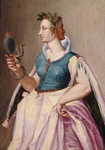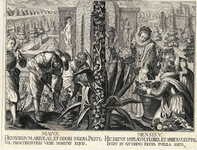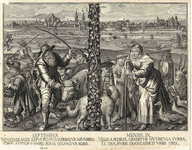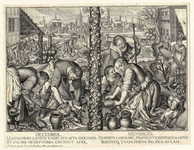Peter Candid
The Annunciation
The Virgin and Child



Aeneas is received by Venus in Olympus

Portrait of Magdalene von Bayern (1587-1628)
Two studies of a Standing Man with a Sword. Alexander the Great






School of Peter Candid
Allegory of Summer
Peter Candid also known as Peter de Witte (I) (other name variations: Peter de Wit, Pieter de Witte, Peter Candido, Pietro Candido) (c. 1548 – 1628) was a Flemish-born Mannerist painter, tapestry designer and draughtsman active in Italy and Bavaria where he worked for many courts.[1]
Life
Peter Candid, Apotheosis of Aeneas, c. 1600. Bode Museum, Berlin.
He was born in Bruges and moved with his parents to Florence at the age of 10. His father was a tapestry weaver who had been hired by the newly opened Medici weaving workshop, the Arazzeria Medicea. Their original family name was de Witte, which they changed to Candido in Italy. Peter would use the family name Candid after he moved to Germany. Peter started his apprenticeship in the early 1560s under an unknown master.[2]
The earliest known record of Candid's work as an artist is in relation to payment for a fresco made in Florence in 1569. He is first mentioned as a member of the 'Accademia del Disegno' in 1576.[1] According to the 16th century biographer Karel van Mander who knew Candid when he visited Italy, Candid worked with Giorgio Vasari on the Sala Regia in the Vatican and on the cupola of the Florence Cathedral. In the period 1582 - 1583 he worked in Rome at the Sala Regia in the Vatican and then returned to Florence.[2]
By 1586 he became employed at the court of Munich upon the recommendation of the sculptor Giambologna. He was first court painter to Duke William V of Bavaria and later Maximilian I of Bavaria. For the Duke and Elector Maximilian, Candid frescoed numerous buildings, including the Munich Residenz and Schleissheim Palace. In the period 1600 to 1628 he was the leading artist in Munich. He was also active as an art dealer and had business dealings with Philipp Hainhofer.[2]
He married and had five children, including a son Wilhelm (fl 1613–25), who was a painter but after 1625 became a court official. His daughter married the engraver Filips Sadeler in 1624.[2]
He was the teacher of Johann Ulrich Loth. He died in Munich.[1]
A segment of Munich’s ring road is named after Candid, as is the metro station Candidplatz.
Work
Allegory of Summer
Candid painted history paintings, portraits, mythological scenes and allegories.[1]
He completed many fresco's and oil paintings in Italy and also made tapestry designs and other works for Cosimo I de' Medici, Grand Duke of Tuscany. His style in Florence was influenced by the school of Michelangelo, although he was closer to Bronzino and Alessandro Allori than to Vasari. His work also shows the influence of the Flemish tradition.[2]
In Munich he initially worked as part of a team of Italian artists under the direction of the Dutch-Italian painter Friedrich Sustris, who had also been in Florence. He realised frescoes after Sustris’s designs for the court. He also produced many altarpieces. He became more autonomous after Sustris died and Maximilian I of Bavaria had ascended the throne at the end of the century. After the Duke set up a tapestry workshop with craftsmen from the Low Countries in 1604, Candid made the cartons of four extensive series of tapestries comprising about 50 hangings worked through with gold on the Deeds of Otto von Wittelsbach, the founder of the Duke’s dynasty, The Months, The Seasons and The Times of Day. He also supervised the execution of the tapestries by the weavers. Candid further was responsible for all interior paintings at the new buildings added by Duke Maximilian to his palaces and continued to realise altar pieces. He executed small paintings on copper panels on religious, mythological and allegorical themes in a Mannerist style.[2]
Sources
Curl, James Stevens (2006). A Dictionary of Architecture and Landscape Architecture (Paperback) (Second ed.). Oxford University Press. p. 880. ISBN 0-19-860678-8.
References
Peter de Witte (I) at the Netherlands Institute for Art History (Dutch)
Brigitte Volk-Knüttel. "Candid, Peter." Grove Art Online. Oxford Art Online. Oxford University Press. Web. 19 Sep. 2014
---
Fine Art Prints | Greeting Cards | Phone Cases | Lifestyle | Face Masks | Men's , Women' Apparel | Home Decor | jigsaw puzzles | Notebooks | Tapestries | ...
---
Artist
A - B - C - D - E - F - G - H - I - J - K - L - M -
N - O - P - Q - R - S - T - U - V - W - X - Y - Z
Retrieved from "http://en.wikipedia.org/"
All text is available under the terms of the GNU Free Documentation License






